Effective Classroom Management Strategies for Kindergarten


Intro
Classroom management is a crucial aspect of teaching, especially in kindergarten. Educators who work with young children face unique challenges that require specific strategies. Young learners have varying levels of attention spans, emotional regulation, and social skills. Therefore, establishing effective classroom management techniques not only enhances the overall learning environment but also supports children's developmental needs. This article delves into practical strategies that kindergarten teachers can employ to create a structured yet flexible atmosphere that promotes engagement and learning.
Creative Activities
Engaging in creative activities is an essential part of early childhood education. Creative tasks allow children to express themselves while reinforcing key concepts in a fun and interactive way. Here are some effective craft ideas that can be easily incorporated into classroom routines:
Craft Ideas
- Paper Plate Animals: Children can create different animals using paper plates, crayons, and other materials. This activity encourages fine motor skills and creativity.
- Handprint Trees: Using their hands as stamps, children can make colorful trees that display the changing seasons. This introduces them to nature and art.
- Shape Collages: Gather various shapes and let kids create their own collages. It helps them recognize and learn shapes along with fostering creativity.
Step-by-Step Guides
Each activity should have a structured process. Here are important steps to ensure smooth execution:
- Gather all necessary materials before starting.
- Demonstrate the activity clearly, highlighting key steps.
- Encourage children to express their own ideas during the craft.
- Provide assistance when needed but allow independence in creation.
Educational Value
Creative activities enhance learning in multiple ways:
- They develop fine motor skills, which are crucial for writing.
- They foster imagination, promoting problem-solving skills.
- They offer opportunities for social interaction and collaboration among peers, crucial for emotional growth.
Fun Quizzes
Quizzes can be a valuable tool for reinforcing learning while making education enjoyable for kindergarteners. They help assess understanding in a playful way.
Quiz Topics
Some of the enjoyable topics could include:
- Colors: Identifying and naming colors in the world around them.
- Shapes: Different shapes encountered daily.
- Animals: Learning about animals and their habitats.
Question Types
Quizzes should have varied question types to maintain engagement:
- Multiple choice questions that require children to choose one answer.
- True or false questions to encourage critical thinking.
- Fill-in-the-blank questions to test knowledge retention.
Knowledge Reinforcement
Through quizzes, young learners can:
- Reinforce key concepts learned in class.
- Develop confidence in their knowledge and abilities.
- Become more engaged in learning through games and quizzes that feel more like play.
Fact-Based Articles
In addition to activities and quizzes, fact-based articles can be a rich source of information for both teachers and students. Educational articles introduce various topics and facilitate curiosity in young minds.
Topics
The articles can cover a range of subjects, such as:
- Animals and their characteristics.
- Plants and their growth cycles.
- Simple science experiments that can be conducted safely in the classroom.
Engaging Content
The goal should be to present information in a way that captures attention. This could mean using bullet points, visual aids, and simple language. The content should be easy to digest, sparking interest and questions from students.
Understanding Kindergarten Classroom Dynamics
Understanding kindergarten classroom dynamics is crucial for creating an effective learning environment. These dynamics are shaped by the developmental characteristics of young children and their interactions with peers and adults. Recognizing these elements allows educators to tailor their approaches, ensuring they meet the needs of all students.
Child Development Principles
Child development principles outline how children grow physically, socially, and cognitively. At this age, children are typically in the early stages of their development. They learn through play, exploration, and interaction. Educators must grasp these principles to devise strategies that align with these natural learning processes. This understanding informs lesson design, classroom layout, and the types of activities that will engage children most effectively.
For example, comprehension of developmental milestones informs when to introduce certain concepts. A child’s cognitive load must match their developmental stage. If a task is too challenging, frustration may ensue. Conversely, if it is too easy, boredom can set in. Thus, understanding these principles enhances educational effectiveness.
Social and Emotional Growth
Social and emotional growth is equally important in kindergarten. Children begin to express emotions, form relationships, and navigate social norms. They learn to communicate, solve conflicts, and demonstrate empathy. Educators who recognize the significance of this growth can implement strategies that foster positive interactions among classmates.
Promoting a supportive environment encourages children to share their feelings. Activities, such as group discussions or role-playing, can be beneficial. They provide spaces for students to express themselves constructively. Moreover, understanding social cues and emotional responses helps educators to guide students through conflicts and emotional challenges they may face.
In summary, understanding kindergarten classroom dynamics encapsulates both child development principles and social-emotional growth. An awareness of these aspects informs effective classroom management strategies, ultimately leading to a more harmonious learning environment.
Setting Clear Classroom Expectations
Setting clear expectations in the kindergarten classroom serves as the foundation for a productive learning environment. When students understand the boundaries and guidelines, they feel more secure and are more likely to engage positively in classroom activities. Clarity in expectations can also help diminish confusion and misbehavior, allowing educators to focus more on teaching than on managing disruptions.
Establishing Rules and Guidelines
Establishing rules and guidelines is essential for guiding student behavior. These rules provide a framework for what is acceptable and what is not within the classroom. It is important to keep the rules simple and age-appropriate. Here are several effective strategies to establish rules and guidelines:
- Involve Students: When creating the classroom rules, involve the students in the process. This engagement can lead to better ownership of the rules and greater adherence.
- State Positively: Phrase rules in a positive manner. For instance, instead of saying, "Don't run in the classroom," say, "Walk calmly in the classroom." This encourages the desired behavior rather than dwelling on the negative.
- Visual Aids: Utilize pictures and symbols to illustrate rules. Since kindergarteners often learn better through visuals, these aids can enhance comprehension and recall.
A well-defined set of rules provides a structured approach that helps students know what is expected of them. This clarity fosters an environment where learning can thrive, laying the groundwork for social and emotional growth.
Communicating to Students
Effective communication with students about these expectations is equally important. It is not enough to simply state the rules; educators must make sure students understand them. Here are some methods for effective communication:
- Model Behavior: Demonstrate the expected behaviors in real time. Show students what it looks like to line up, raise hands, or share materials. Modeling can significantly enhance understanding.
- Regularly Revisit Expectations: Consistently review the classroom rules so that they remain fresh in students' minds. This can be integrated into daily routines or during circle time.
- Use Clear Language: When discussing rules, choose language that is simple and straightforward. Avoid using complex phrases or ideas, as they may confuse young learners.
Children are responsive to clear, consistent communication. When they know what is expected and understand the reasoning behind the rules, they can take an active role in following them.
Establishing clear expectations fosters an environment of respect and cooperation, creating a positive atmosphere conducive to learning.
Creating a Positive Learning Environment
Creating a positive learning environment is crucial in a kindergarten classroom. Young children thrive in spaces where they feel safe, valued, and engaged. When educators prioritize this environment, they set the stage for effective learning and growth. A supportive atmosphere also fosters children's social skills and emotional well-being. This section will detail the specific elements that contribute to a positive classroom dynamic.
Physical Space Arrangement
The arrangement of physical space in a kindergarten classroom can greatly impact children's learning experiences. A well-structured classroom layout can enhance focus, collaboration, and movement. Here are several key considerations:
- Accessibility: Ensure that materials are available and easy to access for young children. Lower shelves allow students to engage with resources independently.
- Defined Areas: Create distinct areas for various activities—such as reading, art, and group work—to provide children with clear expectations about where to go and what to do. This setup aids in transitioning between activities smoothly.
- Comfortable Seating: Utilize a variety of seating options, including cushions, small tables, and floor seating. This flexibility accommodates different learning styles and encourages collaboration.
An effectively arranged classroom promotes a sense of ownership and responsibility for the space. It also reduces distractions, allowing students to concentrate on tasks more effectively.
Visual Cues and Supports
Visual cues and supports play a significant role in guiding kindergarten students through their daily activities. Because young learners are often still developing verbal skills, visual aids can enhance their understanding of expectations. Consider the following points:
- Labels: Clearly label areas of the classroom, such as the reading corner or art station. Labels in both written words and pictorial representations assist in comprehension and navigation.
- Charts and Posters: Use charts to illustrate routines, rules, and schedules. Colorful and age-appropriate visuals can capture attention while conveying necessary information.
- Interactive Displays: Incorporate areas where students can engage with the environment, like a
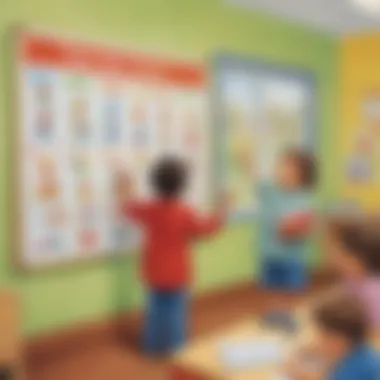
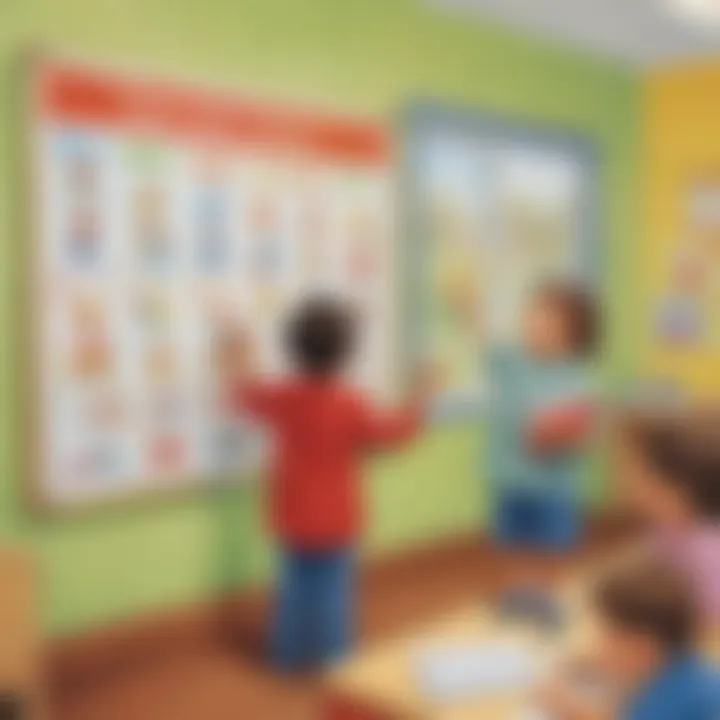
Utilizing Positive Reinforcement Techniques
Types of Reinforcement
There are various forms of positive reinforcement that teachers can utilize. Here are some common types:
- Verbal Praise: Simple words of encouragement can have a powerful effect. Saying “Great job!” or “I am proud of you!” boosts self-esteem and motivates students.
- Physical Rewards: Stickers, certificates, or tokens can celebrate achievements. These tangible rewards serve as reminders of accomplishment and can encourage further success.
- Extra Playtime: Offering additional free time or special activities as a reward can be highly effective. This aligns the reward with children’s natural desire to play, making the reinforcement more impactful.
- Classroom Privileges: Allowing students to be ‘helper of the day’ or choose a game for the class fosters a sense of responsibility and belonging among students.
Incorporating these forms of reinforcement helps to create an engaging atmosphere where children feel valued and understood.
Implementing Reward Systems
To successfully implement reward systems, consistency is key. Establishing a clear system sets expectations for students. Here are some steps to consider:
- Define Goals: Clearly outline what behaviors are being reinforced. This clarity helps students understand what is expected and encourages them to strive toward these behaviors.
- Create a Visual Chart: Use a simple chart or board. Display how many rewards each student has earned. Visual aids can motivate students to participate actively in the reward system.
- Make Rewards Accessible: Ensure that rewards are attainable for all students. Consider offering different levels of rewards to accommodate varying abilities and achievements.
- Review and Adjust: Frequently assess the effectiveness of the reward system. Be open to adjusting it based on student feedback and the behaviors observed in the classroom. This adaptability ensures the system remains relevant and engaging.
By using positive reinforcement techniques effectively, educators not only enhance behavior but also contribute to a thriving learning environment.
Incorporating Collaborative Learning
Collaborative learning stands out as a vital strategy in kindergarten classroom management. This approach promotes interaction among students, enabling them to learn from each other. Through group work, children not only develop academic skills but also essential social and emotional competencies. Engaging in collaborative activities fosters a sense of community. When students collaborate, they share ideas, solve problems together, and support one another's learning. This interaction is crucial for young learners, who often benefit from the guidance and support of their peers.
Benefits of Group Work
Group work in the kindergarten setting offers numerous advantages:
- Enhanced Communication Skills: Children learn to express their ideas clearly and listen to others. Communication forms a core component of effective group work.
- Development of Interpersonal Skills: Cooperation in groups teaches crucial social skills. Children learn to negotiate, share, and resolve conflicts.
- Increased Engagement: Working in groups can make learning more enjoyable. It motivates students to take part in activities, leading to higher engagement levels.
- Diverse Perspectives: When children collaborate, they bring varied viewpoints to the table. This diversity enriches discussions and helps develop critical thinking.
- Boost in Confidence: Sharing responsibility in group tasks can help shy students become more confident in their abilities. They feel valued when their contributions matter.
These benefits demonstrate why incorporating collaborative learning is key. It establishes a more dynamic and interactive learning environment that nurtures young minds.
Structuring Group Activities
To effectively incorporate collaborative learning, teachers must thoughtfully structure group activities. Consider the following aspects when designing these activities:
- Clear Objectives: Define what you want the students to learn. Clear goals guide the group work and help maintain focus.
- Balanced Groups: Create diverse groups. Mixing students of different abilities and backgrounds encourages inclusivity and maximizes learning potential.
- Role Assignment: Assign specific roles within the groups. This ensures that every child has a responsibility, fostering accountability and participation.
- Guided Instruction: Provide support throughout the activity. Monitor the groups and offer guidance when necessary, emphasizing productive collaboration.
- Reflection: After the activity, encourage students to reflect on their experiences. Discuss what worked well and what could improve for future activities.
Following these steps helps create an organized environment where collaborative learning can thrive, ultimately enhancing student outcomes in the classroom.
Building Strong Relationships with Students
Building strong relationships with students is essential for effective classroom management in kindergarten. These relationships create a foundation for trust and respect, which are critical for young children's learning. When students feel valued and understood, they are more likely to engage in classroom activities and follow established routines. Fostering such relationships can mitigate behavioral issues and promote a positive learning environment.
Establishing Trust and Rapport
Establishing trust and rapport involves creating a safe atmosphere where students feel comfortable expressing themselves. Teachers play a key role in this process, as their attitude directly influences how students perceive their classroom. Simple gestures such as greeting students warmly each day or remembering their names and preferences can have a significant impact.
One effective way to build trust is through consistency. When teachers are consistent in their actions and expectations, students learn they can rely on their guidance. Additionally, sharing personal stories and experiences can humanize teachers, making them more relatable and approachable. It is important for educators to model vulnerability, showing students that everyone makes mistakes and learns from them.
Key elements to consider include:
- Empathy: Understanding and responding to students' needs enhances trust.
- Availability: Being accessible and approachable fosters an open connection.
- Encouragement: Praise and support help build a sense of belonging.
Encouraging Open Communication
Open communication is vital in developing strong relationships. We need to create an environment where students feel free to share their thoughts and feelings. This includes fostering a space where questions are encouraged and mistakes are treated as learning opportunities.
Teachers can facilitate open communication by using various strategies. Regular check-ins with students can provide insights into their thoughts and emotions. Activities like morning meetings or circle time create an avenue for students to express themselves collectively. Encouraging students to ask questions helps them feel more integrated into the classroom experience.
Teachers should also challenge their students to articulate their feelings or concerns. When children express themselves, it not only validates their feelings but also enhances their language skills. Trust innovations will develop when students perceive their teachers as dependable listeners.
“A teacher who listens can help shape a child's emotional literacy.”
In summary, building strong relationships with students is not merely a component of classroom management; it is a foundation. Trust and open communication form a strong partnership between educators and students, greatly enhancing the educational experience.
Maintaining Structure and Routine
Maintaining structure and routine in a kindergarten classroom is essential for fostering an environment conducive to learning. Young children thrive on predictability. Routine provides a sense of security, helping them to understand what to expect throughout the day. This consistency also aids in reducing anxiety, allowing students to focus better on their learning activities. A structured environment can enhance classroom management, as children are less likely to engage in disruptive behaviors when they know what is expected of them.
Daily Schedules and Predictability
Creating a clear and predictable daily schedule is vital in kindergarten settings. A well-organized timetable helps students familiarize themselves with the rhythm of the school day. It typically includes various components such as circle time, individual learning, and playtime. Each segment should be thoughtfully arranged to maintain engagement and flow. For example:
- Morning Circle: Discussion and sharing time.
- Learning Stations: Hands-on activities focused on different skills.
- Snack Time: A break for nourishment and relaxation.
- Outdoor Play: Time for gross motor skills development.
Communication of the daily schedule can be done visually using chart paper or images. This not only aids the memory of students but also allows them to anticipate upcoming tasks. When children know what comes next, they are less likely to feel overwhelmed or frustrated.
Transitions Between Activities
Transitions can often be a challenging time in the classroom. However, with proper planning and generation of fun, engaging, and smooth transitions, they can become effective learning moments. Preparing students for the switching of activities is crucial.
For instance, the teacher can use a timer or countdown to signal a nearing transition. An auditory cue, like a bell or song, can also be effective. Engaging students in direct communication about what to expect helps in minimizing resistance to change. Moreover, establishing simple routines such as:
- Signal for Attention: Using a specific sound or gesture to gain the students' focus.
- Movement Activity: Short physical activities or stretches before transitioning can energize students.
- Reflective Discussion: A brief conversation about what they learned in the previous activity can help them reconnect with their learning.
"A structured routine allows students to navigate the school day with confidence and security."
Ultimately, maintaining structure and routine in a kindergarten classroom is not merely about discipline. It is an investment in nurturing resilient, enthusiastic learners prepared to meet each new challenge with enthusiasm.
Adapting to Individual Student Needs
Adapting to individual student needs is a crucial component of effective classroom management, especially in a kindergarten setting. This approach acknowledges that each child comes into the classroom with unique backgrounds, experiences, and learning styles. Recognizing these differences allows educators to create an inclusive environment that fosters academic growth and emotional well-being.
In kindergarten, students are at various developmental stages, which influences how they learn and interact. By tailoring their teaching methods, educators can ensure that all students feel valued and understood. When educators adapt their instruction to meet individual needs, it enhances student engagement and helps in building a stronger classroom community. This practice also reduces frustration for students who might struggle with a one-size-fits-all approach.
Differentiating Instruction
Differentiating instruction involves modifying lessons, materials, and assessments to cater to the varying needs of students. Educators can achieve this by using different strategies such as flexible grouping, tiered assignments, and varied instructional approaches. For example, some students may grasp a concept quickly through visual aids, while others might understand better with hands-on activities.
To differentiate effectively, teachers can:
- Assess students’ prior knowledge and skills to inform their planning.
- Use small groups to target specific learning objectives based on performance levels.
- Offer choices in how students can demonstrate what they have learned.
By implementing differentiated instruction, educators promote a sense of agency and respect for each child’s learning journey.
Recognizing Diverse Learning Styles
Every child possesses a unique learning style, making it essential to recognize and accommodate these differences in a kindergarten classroom. Common learning styles include visual, auditory, and kinesthetic. Understanding these styles enables educators to design activities that resonate with all students.
A few strategies to recognize and incorporate diverse learning styles are:
- Assessment: Conduct informal assessments or observations to identify where each child excels.
- Varied Activities: Create lessons that integrate visual presentations, discussions, and hands-on tasks to reach different learners.
- Feedback: Encourage students to express their preferences regarding how they learn best.
Acknowledging and responding to diverse learning styles not only aids in learning but also promotes an atmosphere of respect and appreciation for individual differences.
Adapting teaching methods to meet individual student needs is not just beneficial for learning. It creates a more inclusive and supportive classroom environment that nurtures the varied backgrounds of preschoolers.
By focusing on these two areas, educators can create a more effective and enjoyable learning experience for all students, ensuring that everyone has the opportunity to succeed.
Engaging Families in the Classroom

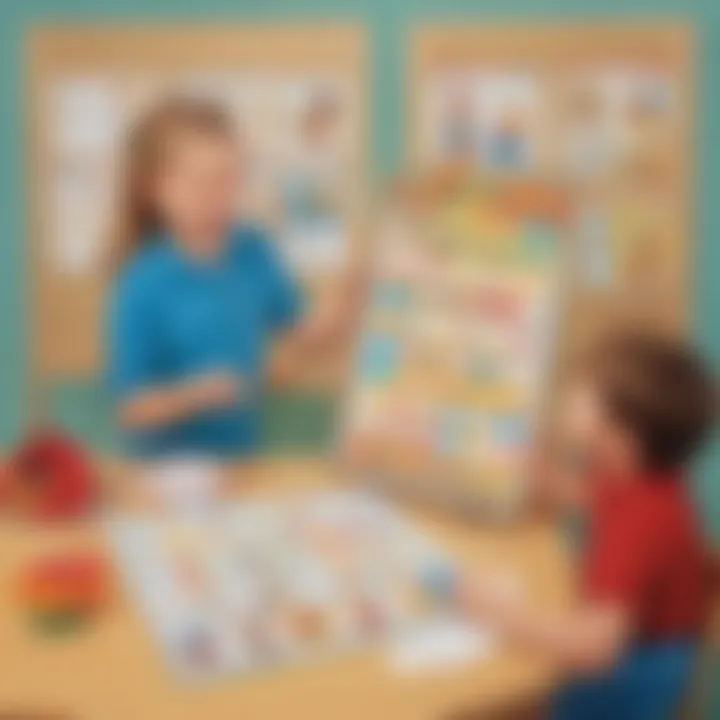
Engaging families in the classroom is crucial for effective management and successful learning outcomes in kindergarten. Involving families can bridge the gap between home and school, creating a stronger support system for students. When families participate in their child's education, it often leads to improved academic performance and emotional well-being for the children. Recognizing the importance of this engagement is essential for educators who aim to create a nurturing and productive environment.
Importance of Parental Involvement
Parental involvement impacts a child's development in numerous ways. Firstly, children feel more secure and valued when their parents take an active role in their education. They are likely to perform better academically and may even develop better social skills. Consistent involvement allows parents to be better informed about their child's progress, strengths, and areas that require more attention.
Several studies suggest that parental involvement reduces disciplinary problems. When families are engaged, there is better communication about expectations and guidelines, which helps reinforce rules both at home and school.
In addition, understanding a child’s background can guide teachers in tailoring their approach. This sensitivity can enhance the teaching style and the content delivered, making learning more suitable and appealing.
Strategies for Communication with Parents
Effective communication strategies are vital for engaging families. You can consider the following methods:
- Regular Updates: Utilize newsletters or digital platforms to provide updates on classroom activities and expectations. These updates keep parents well-informed and engaged.
- Parent-Teacher Conferences: Schedule regular meetings to discuss individual student progress. This interaction allows for personal feedback and joint problem-solving related to student challenges.
- Inclusive Events: Organize events such as open houses or family nights. Such gatherings foster a community atmosphere and promote relationship building among parents, teachers, and students.
- Surveys and Feedback: Send out surveys to understand parents' concerns, preferences, and suggestions regarding classroom management and learning approaches. This will facilitate a dialogue and make them feel heard.
- Technology Utilization: Use communication apps like ClassDojo or Remind to send quick updates and receive immediate feedback. This not only saves time but also accommodates busy schedules.
Engagement strategies can turn communication into a two-way street. This effort not only enriches the educational experience but ensures a consistent approach towards student development.
Involving families is not just an add-on; it is a core element that underpins a child's education and classroom management.
Responding to Behavioral Challenges
Effective classroom management in kindergarten necessitates understanding and addressing behavioral challenges. Young children undergo significant emotional and social development. As they navigate their first experiences in structured environments, ambiguity can lead to misbehavior. It is crucial for educators to recognize these challenges as opportunities for guiding positive behavior and learning.
Understanding Common Behaviors
In a kindergarten setting, behaviors often stem from underlying emotions. Children may exhibit signs of frustration, anxiety, or excitement. Some common behaviors include:
- Tantrums: These are typical when a child's needs are not met. They can signify feelings of being overwhelmed or unable to express discomfort verbally.
- Impulsivity: Kindergarteners are still developing impulse control. They might blurt out answers or interrupt conversations. This behavior reflects their eagerness to engage, but also their developmental stage.
- Withdrawn Behavior: Some children might retreat into silence or avoid participation. This may arise from shyness or discomfort in social situations.
Recognizing these behaviors is the first step. Educators need to observe patterns and environmental triggers that lead to such actions. Reflective practice—where educators consider their response to misbehavior—can deepen understanding of each child's unique circumstances.
Intervention Strategies
When addressing behavioral issues, intervention must be purposeful and informed. Here are some effective strategies:
- Proactive Approaches: Preventive measures can help avoid challenging behaviors. Setting clear expectations and providing structured routines allows children to know what is acceptable.
- Teach Coping Skills: Introducing techniques for managing emotions is essential. Educators can guide students to recognize their feelings and suggest strategies like deep breathing or counting to ten when upset.
- Positive Reinforcement: Reinforcing desired behaviors through praise or small rewards can motivate children to repeat those actions. For instance, recognizing a child who shares toys successfully encourages further cooperation.
- Behavioral Contracts: Involving students in creating agreements for their behavior gives them ownership of their actions. Simple charts to track good behavior can be effective.
- Parent Collaboration: Engaging with parents to establish consistency at home and school further supports children’s behavior management. Open lines of communication can cultivate a united front that reinforces positive behavior.
Important Note: Consistency is key. All strategies must be applied uniformly to create a reliable and safe environment for the children.
Overall, employing these techniques allows educators to respond thoughtfully to behavioral challenges. It fosters a positive atmosphere conducive to learning and development.
Incorporating Technology in Management
In today’s digital age, the integration of technology in the classroom is an essential aspect of effective classroom management, especially for kindergarten educators. By leveraging technology, teachers can enhance engagement, streamline processes, and provide tailored support for each child's learning journey. This incorporation can assist in creating not only an interactive environment but also a data-rich setting that informs instructional choices.
Utilizing technology in classroom management does not just mean having a smart board or tablets available. It involves a thoughtful approach to selecting and implementing educational tools that serve specific pedagogical purposes. Considerations for using technology include assessing how it can complement traditional teaching methods and how to integrate it into daily activities in a seamless manner.
Utilizing Educational Tools
Educational tools can enhance various aspects of classroom management. Software applications, platforms for classroom communication, and learning management systems can play pivotal roles. Here are some examples:
- Classroom Management Apps: Applications such as ClassDojo allow teachers to track student behavior and communicate with parents easily. This fosters a connected environment and helps reinforce positive behavior.
- Interactive Learning Games: Programs like ABCmouse offer engaging activities that promote literacy, math, and social skills, enabling children to learn while having fun.
- Digital Resources: Websites such as Starfall provide interactive reading experiences that cater to diverse learning styles.
Choosing the right tools requires understanding the needs of your classroom. Technology should be used to support educational goals, streamline communication, and provide feedback to students and parents.
Monitoring Student Progress
Monitoring student progress through technology offers educators an efficient means of assessing learning outcomes. Various platforms provide analytics that can track each child’s performance over time. This data is invaluable for identifying areas of strength and those needing further support.
For instance:
- Learning Management Systems: Platforms like Google Classroom allow teachers to assign tasks, grade work, and provide comments all in one place. They provide insights into individual student performance.
- Assessment Tools: Online quizzes and formative assessments can quickly gauge understanding of material covered. Tools like Kahoot! make these assessments engaging and fun, encouraging participation.
- Digital Portfolios: Keeping digital portfolios on applications like Seesaw allows students to document their learning journey. Parents can easily access this information, promoting transparency and involvement.
Technology, when used thoughtfully, can transform classroom management in kindergarten by offering insights that lead to more informed instructional decisions.
In summary, incorporating technology into classroom management is a strategic approach. Teachers need to select appropriate educational tools and effectively monitor student progress. This assists in enhancing the learning environment and supporting the needs of all students.
Evaluating and Adjusting Strategies
In the realm of kindergarten classroom management, evaluating and adjusting strategies is essential for creating an effective learning environment. This process involves regularly assessing how well current techniques are working and making necessary changes based on student responses and outcomes. Having a flexible approach ensures that educators can address unique challenges and adapt to the developmental needs of young children.
Constant evaluation helps in identifying what's effective and what isn't. This proactive stance leads to better engagement and learning experiences for students. Teachers must consider various elements when evaluating strategies: the behavior and participation of students, the alignment of activities with learning objectives, and the overall classroom atmosphere.
Assessing Effectiveness
Assessing effectiveness requires a thoughtful look at both qualitative and quantitative data. This means observing students during activities and analyzing their progress over time. Questions educators can ask include:
- Are students meeting learning objectives?
- Is the classroom environment conducive to learning?
- How are students interacting with one another and with the teacher?
Incorporating feedback from students is also a critical aspect. By asking children about their experiences, educators can gain insights that may not be visible through observations alone. These assessments help to pinpoint specific areas needing improvement.
Fine-tuning Approaches
Once the assessment is complete, fine-tuning approaches becomes the next step. This process involves making subtle changes to existing strategies or implementing new techniques that better suit the classroom dynamics. Consider the following:
- Adjusting Group Configurations: If a certain group dynamic is not working, try rearranging the groups to enhance collaboration.
- Modifying Instructions: Simplifying directions or breaking them down into smaller steps can support student understanding.
- Introducing New Tools: Sometimes, a new educational tool or resource can invigorate a lesson and foster engagement.
Fine-tuning requires ongoing attention and willingness to experiment. Despite the best initial plans, classrooms are dynamic environments. Regular adjustments lead to improved outcomes, fostering a positive and enriched learning experience.
Professional Development for Educators
Professional development for educators serves as the backbone of effective teaching strategies in the kindergarten setting. Continuous learning is crucial for teachers to adapt to evolving educational methods, understand child development better, and enhance their classroom management abilities. The rapidly changing educational landscape demands that educators be well-equipped to meet the diverse needs of their students. Furthermore, the engagement in professional development often leads to improved teaching practices and student outcomes.
The benefits of professional development are multi-faceted. Firstly, it enriches the knowledge base of educators, allowing them to stay informed about the latest teaching techniques and educational research. Secondly, it provides opportunities for educators to share insights and experiences, enhancing their understanding of various classroom strategies. As a result, students benefit from more informed and experienced instruction.
There are several considerations regarding professional development:
- Relevance: Professional development activities must align with the specific needs of kindergarten educators and the developmental stages of their students.
- Accessibility: Opportunities should be accessible and practical, allowing educators to apply what they learn in their daily teaching.
- Support: Ongoing support from administration and mentoring is important for sustaining the effects of training.
Investing in professional development is not merely a benefit to educators but serves as a direct investment in the future of students and the educational community at large.
Ongoing Training Opportunities
Ongoing training opportunities are essential for kindergarten educators. These training programs address various aspects of classroom management, child development, and instructional strategies. Teachers engaged in such training often report increased confidence and effectiveness in the classroom. Opportunities may come in the form of workshops, online courses, or professional conferences.
Here are some key types of ongoing training opportunities available:
- Workshops and Seminars: These often focus on specific techniques, such as behavior management or differentiated instruction.
- Online Courses: Flexible learning options, enabling educators to learn at their own pace and focus on areas of interest.
- Peer Observations: This method allows educators to learn by observing their colleagues in action, thus gathering practical insights and techniques.
An added advantage of ongoing training is that it fosters a culture of lifelong learning among educators, encouraging them to seek continuous improvement and share knowledge.
Networking with Peers
Networking with peers is another significant component of professional development. Engaging with other educators provides opportunities for collaboration and innovation in teaching practices. Teachers can share successful strategies, explore challenges, and discuss solutions in a supportive environment. This sharing of knowledge can lead to a stronger sense of community, which is crucial in educational settings.
Benefits of networking include:
- Access to Diverse Perspectives: Teachers gain insights from educators with varying experiences and approaches, enriching their understanding and practice.
- Support System: Establishing relationships with peers provides emotional support and encouragement, which can be vital in challenging teaching situations.
- Resource Sharing: Educators can share resources, lesson plans, and materials, making it easier to implement new ideas in the classroom.
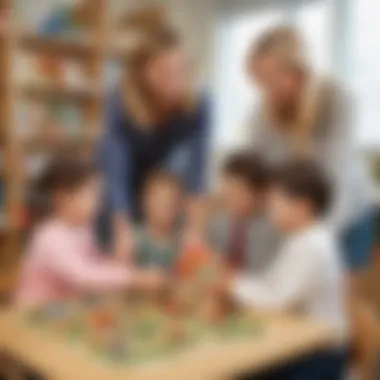
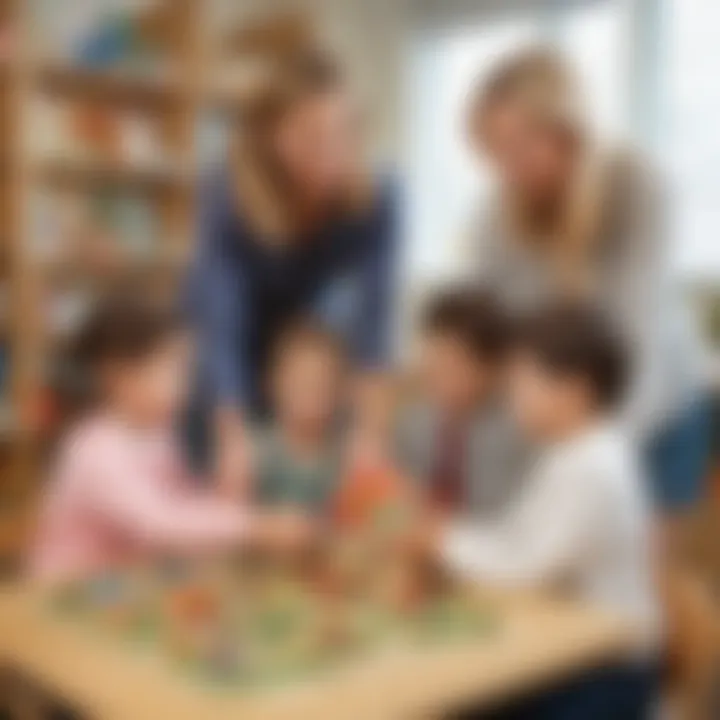
In summary, professional development is fundamental for educators in managing kindergarten classrooms successfully. By engaged in ongoing training and networking with peers, teachers enhance their practices, fostering a productive learning environment for their students.
Cultural Sensitivity in the Classroom
Cultural sensitivity holds significant importance in the kindergarten classroom. The early years of education provide a crucial foundation for children's social and emotional development. Understanding cultural differences nurtures respect and tolerance among young learners. This awareness contributes to a more inclusive and positive classroom environment.
Recognizing Cultural Differences
Recognizing cultural differences involves acknowledging and appreciating the diverse backgrounds of students. Each child brings unique experiences, beliefs, and traditions to the classroom. Educators must make a conscious effort to learn about these varied cultures. This includes understanding a child's language, family dynamics, customs, and values.
By embracing cultural differences, teachers can create a sense of belonging for all students. Such an approach encourages children to feel valued and understood. One effective way to recognize cultural differences is to include multicultural books and resources. This exposure can help children see themselves in the curriculum and learn about others.
Moreover, teachers can hold discussions about various cultures. This elevates awareness and promotes empathy among students. Through activities such as cultural days or celebrations, children can share their heritage with peers. This not only fosters collaboration but also enhances the classroom's cultural fabric.
Incorporating Diverse Perspectives
Incorporating diverse perspectives involves integrating various viewpoints into the classroom activities and discussions. Acknowledging different opinions and values lays the groundwork for critical thinking. Educators can achieve this through diverse lesson plans that reflect the backgrounds of all students.
Using teaching styles that accommodate different cultural perspectives is essential. For instance, group activities encourage collaboration. Children can learn from each other and develop a broader understanding of the world. Teachers can also invite guest speakers from various cultural backgrounds. This enriches the learning experience and provides students with real-world insights.
Additionally, assessing student work can be approached with a cultural lens. Understanding that children may express their understanding of concepts differently is critical. This flexibility allows for a more inclusive assessment methodology.
Embracing cultural sensitivity not only enriches the learning experience but also prepares children for a global society.
In summary, cultural sensitivity in the classroom prepares students for a diverse world. By recognizing cultural differences and incorporating diverse perspectives, educators set the stage for an enriching learning environment. This empowers young learners and builds the foundation for future interactions in a multicultural society.
The Role of Play in Learning
In the kindergarten classroom, play is not merely a leisure activity. It is a fundamental component of how young children learn and develop. Understanding the significance of play is essential for educators aiming to create effective classroom management strategies.
Play fosters creativity, promotes social interactions, and enhances cognitive skills. It provides children opportunities to explore, experiment, and make sense of the world around them. Additionally, it enables emotional expression and helps build resilience, as children navigate both wins and losses in their play.
Teachers who integrate play into their strategies can cultivate a more engaging and dynamic learning environment. This approach aligns with child development principles, recognizing that young learners thrive in settings where they feel safe and free to explore through play.
Understanding Play-Based Learning
Play-based learning is an educational method that uses play as the primary medium for learning. It shifts the focus from traditional teaching methods to a more hands-on approach. This allows children to investigate and interact with their environment in meaningful ways. There are several key aspects to consider:
- Child-Centered Approach: Play-based learning puts the needs and interests of children first, allowing them to take charge of their learning.
- Integrated Curriculum: Through play, various subjects like mathematics, science, and literacy can be interconnected, making learning holistic and relevant.
- Active Participation: Young learners engage actively through play, which enhances retention and understanding of concepts.
Additionally, research supports that play-based learning leads to better social skills, higher levels of engagement, and improved problem-solving abilities. This method also respects individual learning styles, making it an ideal choice for diverse classrooms.
Implementing Play in Class Activities
To effectively implement play in classroom activities, educators need to create opportunities and environments that encourage exploration and creativity. Here are some practical strategies:
- Designated Play Areas: Creating specific areas in the classroom for different types of play—such as dramatic play, construction, or sensory activities—allows children the freedom to choose how to engage.
- Structured Playtime: Incorporating structured playtime within the daily schedule gives children a sense of predictability while allowing for intentional learning goals. It encourages interaction with peers and promotes teamwork.
- Incorporating Play into Lessons: Using games and play-based activities to teach academic concepts can make lessons more exciting. For instance, using math games can reinforce counting and number recognition.
Research indicates that structured yet playful learning experiences contribute significantly to the cognitive and social development of young children.
In summary, the role of play in learning cannot be understated. By understanding and implementing play-based methods, kindergarten educators can create enriching, positive environments that cater to the developmental needs of their students. This strategy not only enhances classroom management but ultimately leads to a more meaningful learning experience.
Fostering a Growth Mindset
Fostering a growth mindset in kindergarten is essential as it lays the groundwork for lifelong learning. A growth mindset is the belief that intelligence and abilities can develop through effort, persistence, and learning from mistakes. This perspective is crucial in early education, as young children are just beginning to understand their own potential.
Teaching children that their abilities are not fixed encourages them to embrace challenges. This shift in perspective helps cultivate resilience, an essential trait for children to navigate academic and personal obstacles in their lifetime.
Encouraging Resilience
Building resilience in kindergarteners involves helping them understand that failure is a natural part of the learning process. When a child faces a challenge, resources must be available for coping and support. Teachers can model resilience by sharing their own experiences of overcoming obstacles.
Activities can include:
- Problem-solving games: Engage students in games where they need to think critically to overcome obstacles.
- Story time: Use stories where characters face challenges, showing how they adapt and grow.
- Experimentation: Allow children to explore different outcomes in their activities. This not only shows them that it's okay to mistake, but that they can learn from them.
“Mistakes are proof that you are trying.”
When children see that their efforts are valued, they will be more likely to try again, even when they encounter difficulties. Encouragement comes from praising effort rather than innate ability.
Promoting a Love for Learning
Promoting a love for learning starts with making education engaging and enjoyable. When children find joy in learning, they are more likely to keep exploring and developing their knowledge.
Key strategies to achieve this include:
- Interactive Activities: Use hands-on activities that stimulate curiosity. For example, science experiments or art projects can spark interest.
- Variety in Teaching Methods: Different learners require different approaches. Balance visual, auditory, and kinesthetic learning activities to ensure all students find something they enjoy.
- Incorporating Play: Learning through play allows children to experiment with concepts in an informal and fun way. This approach sustains curiosity and enthusiasm.
Encouraging questions is also vital. Creating an environment where inquiries are welcomed fosters a sense of adventure in learning. When children feel safe to ask questions, their natural curiosity flourishes.
The Importance of Patience and Consistency
Classroom management in kindergarten goes beyond basic disciplinary actions. It requires a thoughtful approach to create a conducive learning space. Patience and consistency are two key ingredients in this process. When educators embrace these qualities, they foster an environment where young learners feel secure and valued.
Patience allows teachers to navigate the often unpredictable behavior of young children. Each child has unique needs and developmental progress. It is vital to recognize that misunderstandings and mistakes are part of the learning journey. An educator's ability to remain calm and composed influences how children respond to challenges. It encourages students to take risks, knowing that their teacher supports them through the process.
Consistency, on the other hand, builds a predictable framework in the classroom. When children know what to expect, they are better able to focus on their learning. Consistent rules, routines, and responses to behavior create a sense of stability. This is especially important in kindergarten, where many children are experiencing their first formal schooling environment. Providing this stability helps reduce anxiety and fosters a sense of belonging.
In summary, the interrelation of patience and consistency is fundamental in kindergarten classrooms. Together, they promote a healthy atmosphere for learning. This approach not only enhances student behavior but also enriches educational experiences.
Practicing Patience in Management
Practicing patience is essential for teachers managing young children’s behavior. Young children often test boundaries as they learn to navigate their surroundings. Educators must listen actively and respond thoughtfully. For example, if a child is disruptive, rather than reacting immediately, a teacher can take a moment to assess the situation. This pause allows the teacher to approach the child with understanding instead of frustration.
Additionally, patience helps to cultivate a connection with students. When teachers take time to engage with children's feelings and experiences, they build trust. As a result, children are more likely to communicate openly. This communication is vital for effective management, as it helps teachers understand the underlying causes of behavior issues. Recognizing this, educators should incorporate strategies that allow them to model patience:
- Use positive reinforcement: Praise efforts and achievements, no matter how small.
- Establish a calm atmosphere: Create a peaceful space using soft colors and inclusive materials.
- Practice mindfulness: Engage in activities that promote awareness and patience, such as deep breathing exercises.
By embodying patience, teachers provide a nurturing environment conducive to growth.
Consistency in Expectations
Establishing consistency in expectations is equally crucial for kindergarten management. Students thrive when they have clear guidelines to follow. Consistency means holding the same standards every day, regardless of the situation. This uniformity helps children understand what behaviors are acceptable.
To effectively implement this consistency, educators should set specific rules and routines. These can be communicated in simple language so that all students comprehend them. Additionally, visual supports are beneficial. Charts displaying rules or daily schedules provide children with a reference point.
It is also important to be consistent in responses to both positive and negative behavior. When children know they will receive the same response regardless of circumstances, they feel secure. For instance, if a student follows the rules, acknowledging that with praise builds motivation. Conversely, if the rules are broken, responding with clear consequences reinforces understanding.
Ending
In this article, we explored the significant role of effective classroom management strategies in kindergarten settings. These strategies are not just essential for maintaining discipline; they are pivotal in fostering a nurturing and stimulating environment for young learners. A well-structured classroom allows children to thrive academically and socially, leading to long-term benefits in their educational journeys.
Summary of Key Strategies
The strategies discussed include:
- Setting Clear Expectations: Establishing rules helps children understand what behavior is expected. Clear communication regarding these expectations is vital.
- Utilizing Positive Reinforcement: Encouragement through rewards can motivate students, promoting desirable behaviors.
- Building Relationships: Creating trust fosters a safe environment where children feel free to express themselves.
- Maintaining Structure: Predictable routines help children feel secure, enabling them to focus on learning.
- Adapting to Individual Needs: Recognizing diverse learning styles and adjusting instruction accordingly fosters inclusivity.
These elements together create a holistic approach to classroom management, enabling educators to handle various situations effectively while respecting each child's unique needs.
Looking Ahead
As we look to the future of kindergarten education, the importance of adapting management strategies to the rapidly evolving educational landscape cannot be overstated. Teachers must remain aware of emerging trends in child development and educational technology. By incorporating innovative practices, educators can enhance their effectiveness. Continuous professional development offers opportunities for teachers to learn and exchange insights on effective management.
The future classroom will likely be more collaborative, with educators and families working together to create a seamless learning experience. This collaboration can lead to strategies that are well-informed by parental insights and community resources.







